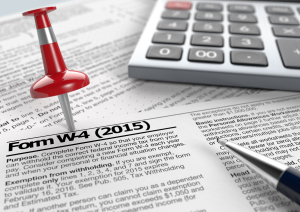
NOTE FOR 2018: The Tax Cuts and Jobs Act that was recently passed by Congress is going to change the IRS withholding tables and how we fill out W4s. Right now, we are still waiting for the IRS to supply the new withholding tables and create the new W4s. This post is about the old W4. I will be updating this as soon as I have new information. But right now, the information below is for 2017 and earlier. I do not expect the new information to be available until mid February.
-Jan
I’ve been getting a lot of questions about how many exemptions to claim on the W-4 (Employee’s Withholding Allowance Certificate) form that you give to your employer. People look at the whole 2 page form and get intimidated. For most people—you should just ignore the rest and concentrate on the little part at the bottom of page one. That’s the part in this screen shot up above. It will make your life a whole lot easier.
First, some questions:
I claimed the wrong number of exemptions on my W-4 and now its tax time and I’m going to claim a different number of exemptions. Will I get in trouble for this?
No you won’t. Your employer doesn’t report you to the IRS for not claiming the right amount of allowances. The worst that will happen is that you owe a lot at tax time or get a big refund. (Actually I don’t think of getting a big refund as being a bad thing. Probably shouldn’t call it a “worst case scenario.”) Neither of those things are crimes. It’s possible that the IRS could inform your employer to increase your withholding if the withholding on your W2 is not enough to cover your tax liability. I have never seen that happen to anyone—but the IRS is allowed to do that if they think it’s necessary.
I don’t want any tax taken out of my paycheck. Can I just claim EXEMPT?
No you can’t. Exempt is only for people who will have no tax liability at all. You might have gotten a refund last year, but it doesn’t mean you have no tax liability. Generally, someone with no tax liability makes less than $5,950 for the entire year. For most people, claiming EXEMPT is a really bad idea.
Okay, so what should I claim? Good question. Here’s my suggestion list. See what category fits your best.
You are a student, either in high school or in college. You’re not married and you don’t have kids. Your parents are allowed to claim you on their tax return (you’re under 24 years old.) SINGLE, ZERO ALLOWANCES
You’ve got a job, only one job, you’re living on your own, and you’re single. SINGLE, ONE ALLOWANCE
Now if you have a child, add another allowance for each child. For example, let’s say you’re single with 2 kids, you’d claim single 3 allowances; one allowance for you and one for each of the children.
Single like above but you’re working two different jobs, SINGLE, ZERO ALLOWANCES – because the two jobs kick you into a higher tax bracket than the withholding would show.
You’re married and only one person works: MARRIED, TWO ALLOWANCES
You’re married and you both work—you’ll each have your own W-4 and they will be different
Spouse #1 with higher paying job—claim MARRIED and all the allowances for the family
Spouse #2 with the lower paying job—claim MARRIED BUT WITHHOLD AT HIGHER SINGLE RATE, ZERO ALLOWANCES
Now this is a pretty simplified guide, but it’s much easier to understand than what is on the form. I also find that people are less likely to get into tax trouble with my rules than when you follow the allowances worksheet.
If you want a really good, accurate calculator to figure your proper withholding, the IRS has one on their website. The problem is, as I’m posting this—the calculator is down. You can use this guide for now and you can always tweak your withholding later when it’s back up. Here’s the link: http://www.irs.gov/Individuals/IRS-Withholding-Calculator
